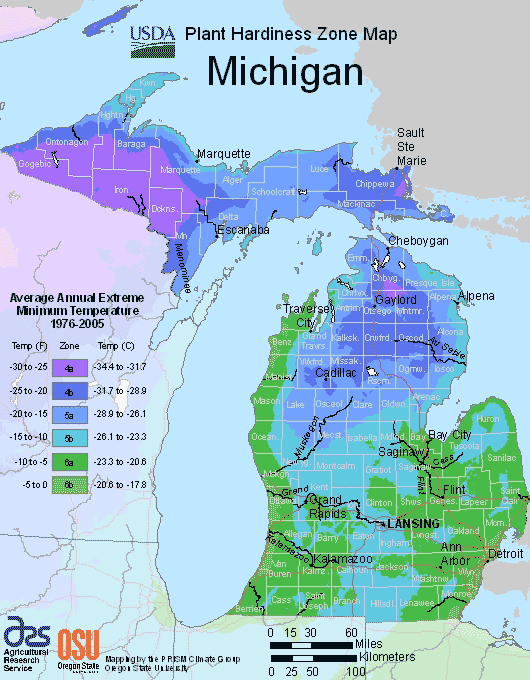
Table of Contents
Characteristics of Michigan Planting Region
Much of the state is vulnerable to extreme weather conditions, such as thunderstorms, twisters, gales, snowstorms, inundations, and abundant snowfall.
In this area, the growing season is quite short and the time to expect frost varies widely. It can start between mid-April and late May and end between September and early November.
Challenges of Growing in Michigan
1. Shorter Growing Season
Michigan residents should anticipate an abbreviated planting season, with only a few months free from frost. Crops of a warmer nature may have difficulty maturing in this compressed period, making it important for gardeners to prepare ahead and perhaps start their seeds indoors.
2. Long, Cold Winters
Gardeners wanting to prolong their outdoor gardening season face challenges due to severe, lengthy winters. Though a mix of indoor and outdoor growing might work, heavy snowfall may obstruct any efforts to cultivate during the winter.
Blooming Beauty: Best Plants for Michigan’s Planting Zone

Michigan’s diverse landscapes, ranging from the Great Lakes to lush forests, provide an exciting canvas for gardening enthusiasts to cultivate a wide range of plants. The state’s planting zones span from Zone 4 in the Upper Peninsula to Zone 6 in the southern regions, offering a variety of climates and growing conditions. By selecting the right plants that thrive in Michigan’s unique environment, gardeners can create a blooming paradise in their landscapes. Here are some of the best plants to grow in Michigan’s planting zone:
- Michigan Wildflowers (Various species): Embracing native wildflowers is an excellent way to add beauty and support local ecosystems. Species like Black-Eyed Susans, Purple Coneflowers, and Wild Bergamot are well-suited to Michigan’s diverse regions and attract pollinators to the garden.
- Lilacs (Syringa spp.): Lilacs are a cherished favorite in Michigan gardens, renowned for their stunning spring blooms and enchanting fragrance. These deciduous shrubs add a touch of nostalgia and beauty to the landscape.
- Hostas (Hosta spp.): Hostas are a popular choice for Michigan gardens, especially in shaded areas. With a variety of sizes and leaf colors available, they bring texture and elegance to the landscape.
- Michigan Blueberries (Vaccinium spp.): Michigan is known for its abundant blueberry production, and growing highbush blueberries is an excellent option for home gardeners. These fruit-bearing shrubs offer delicious berries and beautiful fall foliage.
- Michigan Maples (Acer spp.): Michigan is abundant with maple trees, including Sugar Maples, Red Maples, and Silver Maples. These majestic trees offer stunning fall foliage and are symbolic of Michigan’s natural beauty.
- Daylilies (Hemerocallis spp.): Daylilies are a low-maintenance perennial that brings an array of colors to Michigan gardens. These hardy plants bloom throughout the summer, adding a cheerful touch to any landscape.
- Hydrangeas (Hydrangea spp.): Hydrangeas are versatile shrubs that thrive in Michigan’s climate. Their large flower heads come in various colors, depending on soil pH, and add a touch of elegance to any garden.
- Michigan Apple Trees (Malus spp.): Michigan’s climate is conducive to growing apple trees, making it an excellent choice for home fruit production. Varieties like Honeycrisp, Gala, and McIntosh are popular choices for their delicious fruits.
- Coneflowers (Echinacea spp.): Coneflowers are tough and adaptable perennials that thrive in Michigan’s planting zone. Their daisy-like flowers in shades of pink, white, and purple attract butterflies and pollinators.
- Michigan Oaks (Quercus spp.): Various oak species are native to Michigan and provide sturdy shade trees for the landscape. Bur Oak, Red Oak, and White Oak are among the common varieties found in the state.
To ensure successful gardening in Michigan, it’s essential to consider the state’s changing seasons and varying microclimates. Michigan experiences cold winters, so selecting cold-hardy plants that can withstand freezing temperatures is crucial.
Proper soil preparation, including adding organic matter and maintaining good drainage, is essential for healthy plant growth. Mulching helps retain soil moisture and regulate temperature, particularly during temperature fluctuations.
Watering practices should be adjusted according to the weather conditions, ensuring plants receive adequate hydration during dry spells and drier periods of the year. Rainwater harvesting can be employed to conserve water and reduce water usage.
Michigan’s proximity to the Great Lakes and humidity can lead to fungal issues, so proper spacing, good air circulation, and disease-resistant varieties are beneficial in preventing plant diseases.
From the enchanting beauty of lilacs and hydrangeas to the delicious fruits of blueberries and apples, the best plants for Michigan gardens celebrate the state’s natural beauty and complement its diverse environments. By embracing the changing seasons and selecting plants well-suited to Michigan’s climate, gardening enthusiasts can create a blooming paradise that enhances the charm of the Great Lakes State.
FAQ
Where is US Zone 6?
Zone 6 stretches from the South (Georgia) to the Midwest (Ohio, Kentucky, Kansas), Southwest (Arizona, Colorado, New Mexico, Utah), and Northwest (Idaho, Montana, Washington, Oregon). Alaska, Maine, Massachusetts, and New Hampshire are also in this zone.
What is my planting zone in Michigan?
The USDA Hardiness Zones for this state are 4, 5 and 6. Zone 4 covers the northern part, Zone 5 is in the middle and Zone 6 follows the eastern and western coastal areas.
What plant zone is Grand Rapids Michigan?
Grand Rapids, Michigan lies in USDA Hardiness Zones 5 and 6. To make the most of your garden, it is important to plant vegetable seeds or transplants at the appropriate time. Knowing the first and last frost dates can help you begin your vegetable seeds at the correct moment.
Where is Zone 6 in Michigan?
The zones of the USDA Hardiness vary in the state, with the northern parts in Zone 4, the middle in Zone 5 and the sides by water in Zone 6.
